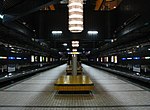Government Centre station
1989 establishments in AlbertaCapital LineEdmonton Light Rail Transit stationsEdmonton Transit Service transit centresMetro Line ... and 4 more
Pages with no open date in Infobox stationRailway stations in Canada opened in 1989Railway stations located underground in CanadaUse Canadian English from May 2013

Government Centre station (formerly known as Grandin/Government Centre station) is an Edmonton Light Rail Transit station in Edmonton, Alberta, Canada. It serves both the Capital Line and the Metro Line. It is an underground station located beneath 110 Street between 99 Avenue and 98 Avenue. The station provides service to the Government Centre part of the downtown core and the neighbourhood of Oliver. The station is connected to the Alberta Legislature Building and several other government buildings by underground walkways of the Edmonton Pedway.
Excerpt from the Wikipedia article Government Centre station (License: CC BY-SA 3.0, Authors, Images).Government Centre station
110 Street NW, Edmonton Central Core
Geographical coordinates (GPS) Address Nearby Places Show on map
Geographical coordinates (GPS)
| Latitude | Longitude |
|---|---|
| N 53.536111111111 ° | E -113.51027777778 ° |
Address
Government Centre
110 Street NW
T5K 1J7 Edmonton, Central Core
Alberta, Canada
Open on Google Maps







